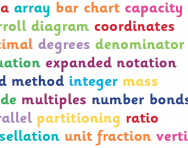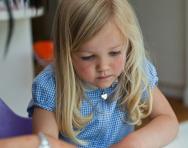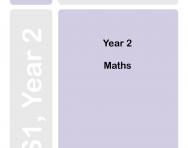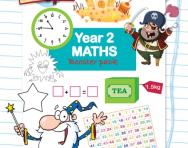SATs revision: your KS1 SATs maths helper
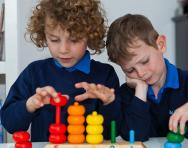
Concerned about KS1 SATs? Put your mind at rest by downloading past SATs papers so you understand exactly what will be tested at the end of Year 2. Keep in mind that KS1 SATs will be non-compulsory from September 2023, so your child may not be sitting them.
If you decide to work through some formal SATs practice activities with your child, try not to overload them: doing one or two questions a day after school can be more beneficial than long periods of sustained concentration which could tire your child out and put them off learning.
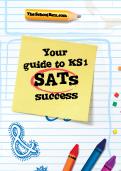
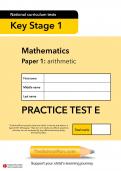
Prepare your child for KS1 SATs today
- Your guide to SATs
- KS1 SATs revision course
- 10 SATs practice papers in English & maths
You can also revise each of the objectives that children need to know by the end of KS1 and make them 'real' with some hands-on learning at home.
Understanding number facts: SATs practice activities
Your child needs to know how to... | Hands-on revision games and activities |
| Write and order two-digit and three-digit numbers | Write lots of different numbers on some small pieces of card. Encourage your child to put the numbers in order from smallest to largest, or challenge them at different points during the day by giving them two numbers and asking them which is biggest. |
| Use the greater than and less than symbols (< and >) | Write two numbers down for your child. Ask them to put a symbol in between the numbers to show which one is biggest. Remind them that the greater than symbol (>) is like a crocodile's mouth which wants to eat the bigger number! (The numbers 58 and 29 would be shown like this: 58 > 29). |
| Round two-digit numbers to the nearest ten | Draw a number line with 30 at one end and 40 at the other. Remind your child that numbers below 35 are rounded down to 30 and numbers which are 35 or above are rounded up to 40. Practise testing them on various numbers. |
| Find one half, one quarter and three quarters of shapes and sets of objects | Empty out a bag of sweets or pasta shapes. Ask your child to count out 12 of them. Ask them to find half of this number. If they struggle, show them how to divide the objects into two equal groups. See if they can find a quarter of 12 as well. |
| Know pairs of numbers with a total of 10, 20 and 100 | Concentrate on number bonds (or number pairs) to 10 for a while and only go onto number pairs to 20 when your child is ready. A good way of learning number bonds to 10 is to write the numbers 0 - 10 on small cards. Encourage your child to match up the numbers to make the number pairs. When they get more confident you can time them doing this for an extra challenge. |
| Know doubles of all numbers to 20 and corresponding halves | It can help to show children how to double numbers by showing them groups of items, such as sweets or counters. Doubles and halves of numbers to 20 are number facts that children need to memorise and 'just know'; test them on their doubles and halves verbally as often as possible. |
| Know all the multiplication and division facts for the 2, 5 and 10 times table | Concentrate on one times table at a time and only go onto the next one when you think they are confident with the one you are working on. There are numerous times tables games, worksheets, activities and learning packs on TheSchoolRun which can help with learning these important facts. |
Calculating: SATs practice activities
Your child needs to know how to... | Hands-on revision games and activities |
| Add and subtract mentally with one-digit and two-digit numbers | Initially, print off a 0 - 20 number line (or you could use a ruler) for your child to use as a maths aid when you test them on adding and subtracting small numbers. Once your child is confident with this, try some Year 2 mental maths questions without the number line. |
| Use the inverse operation (addition is the inverse of subtraction) | Revise the concept of the inverse operation by showing your child 2 counters in a group and 3 counters in a group. Explain to them that 2 + 3 = 5. Then show them 5 counters all together and take 2 away (5 - 2 = 3). |
| Use informal written methods to multiply and divide | Your child may be asked what 3 lots of 4 are, or what 15 divided into 3 equal groups is. The best way to show them this is with groups of counters. |
| Use the symbols +, -, x, ÷ and = to record and interpret number sentences | For all of the above activities, encourage your child to write down the number sentences they are working on. For example, if you've asked them to work out 3 lots of 4, encourage them to write this on a piece of paper as 3 x 4 = 12. |
| Solve problems involving all four operations, money and measures | In order to make maths 'real' for children it's important to challenge them with problems that are related to things happening in their everyday life. For example, when you are buying a chocolate bar costing 40p and a bag of nuts costing 50p, ask them to write down these amounts and see if they can work out the answer. |
Shape, space and measures: SATs practice activities
Your child needs to know how to... | Hands-on revision games and activities |
| Describe the properties of common 2D and 3D shapes | Ask your child to go around the house looking for the following shapes: circle, square, triangle, rectangle, cylinder, sphere, triangular prism, cube and cuboid. Check that they know the difference between 2D and 3D shapes, as well as shapes' names and properties. |
| Identify symmetry in patterns and 2D shapes | Take one of the 2D shapes they have found above (for example, they may have found a piece of paper which is a rectangle). Ask them if this shape has a line of symmetry. Show them what this means by folding the paper in half. Does it have any other lines of symmetry? |
| Recognise and use whole, half and quarter turns, both clockwise and anti-clockwise | Show your child how to make turns by getting them to stand in the middle of the room. Stand next to them and show them what a quarter turn clockwise looks like. Ask them to predict what they would be facing if they made a half turn anti-clockwise. Get them to make the turn and check if they are right. |
| Estimate and measure objects using metres, centimetres, kilograms and litres | Put a group of objects on a table for your child (for example: a bag of rice, a bottle of water and a book). Ask them which ones they would weigh, which ones they would measure using a measuring jug and which ones they would measure the length of. See if they can estimate measurements for each one and then give them the appropriate equipment to check if they were correct. |
| Read the time to the quarter hour and calculate time intervals | Print out and make a paper practice clock to help your child in telling the time. Take every opportunity to ask your child what the time is and also encourage them to calculate time intervals (for example, if it is 2.30 ask them what time it will be in half an hour). |
Handling data: SATs practice activities
Your child needs to know how to... | Hands-on revision games and activities |
| Answer questions on a block graph, pictogram or bar chart | First of all make sure that both you and your child are clear about the different data presentation charts used in KS1 (pictograms, tally charts and bar charts). Look through our Y2 data handling worksheets to practise reading charts and graphs. |
| Produce their own block graphs, pictograms or bar charts | The key to making data handling engaging is to link it to your child's interests. Can they survey the types of cars they see driving past? Their favourite biscuits? Most successful footballers? Whatever they're into, it can be represented in chart or graph form! |
For more KS1 SATs practice activities see our Y2 English SATs helper, our guide to what is tested in the KS1 maths SATs and the KS1 English SATs and all our other SATs information for parents.

Give your child a headstart
- FREE articles & expert information
- FREE resources & activities
- FREE homework help

